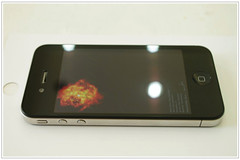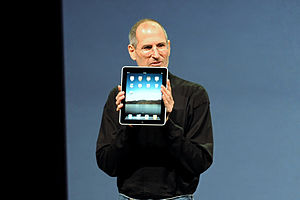One of the more interesting features that will be coming to the iPhone and iPad in the future is NFC. NFC stands for Near Field Communication. What NFC technology would do for the iPhone is let iPhone customers use their phones to pay for transactions. Some examples of NFC devices are the Mobile Speedpass or a credit card that you tap on a payment device, in order to charge your card account.
Currently there are opportunities for iphone customers to pay with their phones such as with the Starbucks Mobile app, however the implementation is not perfect. Inside the app, a barcode is displayed to be scanned at the register. There seems to be a large delay in the reading of the barcode and sometimes the barcode will not even scan. These issues could be as a result of things trivial like the angle the iPhone is held at amount of light given off by the backlight.
Some of these issues would ideally be fixed by NFC technology. Users would only have to have a device onto or next to a reader rather than at a specific angle or using certain default settings. However NFC technology also incorporates a new threat which is security. With RFID, there is a lot of debate about security in that people with special devices, pick up RFID information from large distances, without users knowing. It will be interesting to see what security precautions NFC will utilize and if it will be safe enough for most people to consider.


- Image by Getty Images via @daylife
There is a lot of pent up lust towards the iPhone moving to the Verizon Wireless network. However users should beware because the iPhone 4 is already outdated and will soon be moving to technological graveyards. Every summer Apple releases a new version of the iPhone. That means in a mere 6 months everyone will experience a form of post purchase dissonance because the iPhone will be moving toward bigger and better features, even possibly 4G.
What people do not realize, is that right now cellular technology is switching to 4G. 4G will lead to faster data connections which hopefully will translate into better service for all. Since 4G is fairly new, there are a few downsides such as data costs, lack of standards, and lack of hardware maturity. Currently the price for data is $50 for 5GBs and $80 for 10GBs. The only devices that support 4G on Verizon are laptop cards because voice standards were not complete to allow for phones. Finally devices are fairly new so they are more bulky and battery life takes a pretty large hit with 4G.
If you could, I would suggest you hold off on a new iPhone. You have waited for years and should be able to wait a few more months. I think it would be stupid to buy an iPhone using old technology which would be obsolete in six months and unless you could afford it.


- Image by Getty Images via @daylife
After years of anticipation, Verizon Wireless finally announced, in cooperation with Apple, that they would get the iPhone 4. This announcement has been something that I have been waiting for two years now. Years of unreliable service due to the unanticipated amount of data usage on AT&T‘s cellular sites has left many iPhone customers unhappy with their wireless service. When the iPhone 4 launches on Verizon, it will be interesting to see how many people switch from AT&T to Verizon. It will also be interesting to see how many current customers on Verizon Wireless were holding back from switching from AT&T, knowing the pour quality of service, that finally purchase the iPhone. Personally, i’m waiting to see what issues arrise on the Verizon Wireless network because of the influx of new iPhone customers.
As an AT&T customer with an Apple iPhone 4, I have been relatively pleased with my service over the past year and don’t see a reason for switching. Many other people however are having consistent connection problems that render their phones useless. It is especially bad for dense, highly populated cities, for AT&T to offer reliable service to all of their customers. My mom for example has a very difficult time getting signal, even with a MicroCell from AT&T. Her wireless service is horrible and the only reasonable service she has is through her land line.
Beginning with the iPhone, the amounts of data that carrier networks have to support has skyrocketed. AT&T simply wasn’t able to supply wireless resources for the demand that the iPhone would place on their towers. I noticed this a couple of years ago. There was a time where dropped calls were the norm and in urban settings in Orange County, CA signal and bandwidth was hard to come by. Now AT&T’s quality of service has at leased improved somewhat. This could very well be the fact however that I am very close to a reliable cellular antenna. However at work, they have installed more attenea’s so that iphone users can get better service where on a normal to busy night, iPhone users could not get data service of any kind.
The wireless capacity at cellular sites are not the only issue. This past year while pre-ordering devices through the AT&T website, their servers became overwhelmed which created chaos of many duplicate and lost pre-orders. This resulted in long lines for customers desperate to get an iPhone, that were not able to pre-order. Then on January 11th, Current Verizon customers were seeing issues visiting their customer portal to check for upgrade eligibility because Verizon’s website servers could not handle the load. Every year at launch time we see incredible lines of people waiting (as I did last year) in order to purchase or upgrade to the next version of the iPhone. Then within several hours, around the world there are thousands upon thousands of device activations going through network servers of AT&T at the same time. Every year we see AT&T’s servers become overwhelmed and result in many unhappy customers that cant use their phones for hours and sometimes even days.


- Image by Photo Giddy via Flickr
I believe that all signs point to “yes” as it will be the day that Steve Jobs will take the stage at the World Wide Developers Conference as he has the past two years to introduce the new iPhone. Information from those familiar with manufacturing processes have concluded that the iPhone should be ready. AT&T has a vacation restriction in effect for June. AT&T store representatives are telling people it should be coming out in the next month. Last and most convincingly, AT&T has modified its data plan offerings which will be available on June 7th.
I will be hoping to hear of the following features on the fourth generation iPhone: a forward looking camera, higher resolution rear camera, camera flash, higher resolution display, micro sim, bigger battery, same chip used in the iPad, design like the “stolen” prototype, and I would pray for an upgrade in storage, battery life and memory. I will be crossing my fingers for a file system accessible to all apps, cloud syncing, wireless syncing to iTunes, and free cheaper tethering (okay that’s not going to happen as AT&T has announced their plans). Cloud syncing probably will not happen because of the new bandwidth caps instated by AT&T. I cannot wait to hear what other new unannounced features the iPhone OS 4 will bring.
Will other carriers get the iPhone? I hope so. I think it would be good for everyone to even out the data usage of iPhone customers a bit. There have been rumors of CDMA iPhones in production and major employees at Verizon working on a big ad campaign but nothing is for certain. My best guess is that CDMA phones will come later this year in order to give AT&T some sense of exclusivity during the begging of the new launch.
In other news there have been some rumors that they may announce update other Apple products on the 7th. It is possible that they may update or introduce something new like the next generation Apple TV but I do not think they will sell them right away as the next generation iPhone will take remarkable resources. iPhone launches are most likely the most busiest set of days for AT&T stores and Apple stores. I don’t believe they could afford to sell another new/updated product on the same day.


- Image via Wikipedia
It seems as though various news sources are pointing out the high international demand for the iPad. One example was in Tokyo Japan where 1,200 people stood in line trying to purchase an iPad. This exemplifies the overwhelming demand of international customers for the iPad as Apple tries to overcome low supply levels in order to meet its unexpected interest. In the past month, the iPad has only been introduced in 10 of the 88 countries that will sell the product and is short on supply everywhere.
Personally I was not surprised or captivated with the iPad or the sales that it experienced. As a new type of device, not many people know why they want one or what they would use it for. Of those who have purchased an iPad, 91% say they are satisfied with their purchase. I would never purchase an iPad in its current form. Originally I was hoping that the iPad would be a smaller landscape product that was based more so off the OS X operating system than the iPhone OS. I want something with a file system that I can manipulate files on between applications. A device which automatically syncs files with my MacBook so I can work on things at home or on the go. My main purpose would be to work on a project at home on my MacBook and then take it with me to work on a mobile device and work on it during my breaks. Currently, I do not see how the iPad would fit in to my lifestyle.
I also was not impressed with the demand of the iPad. Maybe I had high expectations for what the iPad could have been but I thought that a tablet-like device should have sold more units up front. Rumors were giving higher numbers which I believed would have set a better pace but those numbers were inflated. It is difficult in one respect because an iPad and an iPhone are similar so many people do not see a reason to have an iPad if they already have an iPhone. On the other hand, I think people should understand the importance of the product more because they have been exposed to the iPhone for so long. For example: many people have been saying that the demand for the iPad is so much greater than the original iPhone. The millionth iPad was sold after 28 days rather than whereas the millionth iPhone was sold after 74 days. This is a great achievement for Apple but now that Apple has introduced the app store, sells millions of iPhones a quarter, and developers have created hundreds of thousands of apps, the million unit amount seems smaller than I would have expected.



